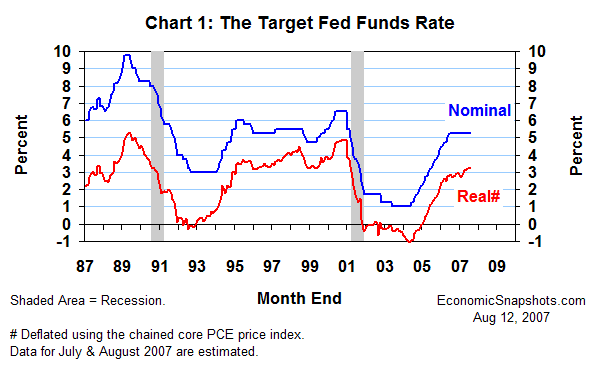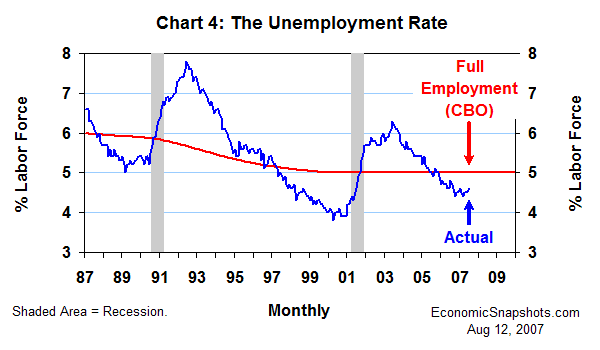
| Back to Index |
Aug 12, 2007 – The FOMC voted last Tuesday to leave its target Fed funds rate unchanged at 5.25%. The Fed funds target has been 5.25% since June last year (Chart 1).

The FOMC’s post-meeting statement said, “Financial markets have been volatile in recent weeks, credit conditions have become tighter for some households and businesses, and the housing correction is ongoing.” Thus, “the downside risks to growth have increased somewhat”.
Even so, the FOMC still forecast a “moderate” trend in real GDP growth. FOMC members expected “solid growth in employment and incomes and a robust global economy” to keep the demand for U.S. goods and services – and U.S. production – growing this year.
In data released since the FOMC’s last monetary policy meeting in June, real GDP rose by a sluggish 1.8% in the four quarters through Q2 (Chart 2).

The FOMC’s July economic forecast (which was compiled at the June meeting) calls for real GDP growth of 2.25% to 2.5% in the four quarters through Q4. To reach this forecast, real GDP must rise at about a 2.5% to 3% average annual rate in Q3 and Q4.
On the inflation front, FOMC members remained cautiously encouraged by recent core inflation data (excluding food and energy prices). “However, a sustained moderation in inflation pressures has yet to be convincingly demonstrated.”
The chained core price index for personal consumption expenditures, the FOMC’s favorite inflation gauge, rose by 1.9% in the twelve months through June (Chart 3). That’s 0.6 percentage points below February’s 2.5% increase.

“Moreover”, the FOMC still worried about the inflation risks posed by “the high level of resource utilization” – especially in the labor market.
In the latest numbers, the unemployment rate edged up by 0.1 percentage points to 4.6% in July (Chart 4). The unemployment rate has been essentially unchanged, at about 4.5%, since September last year.

According to the Congressional Budget Office (CBO), the unemployment rate’s “full-employment” level (the lowest level consistent with the FOMC’s goal of long-run price stability) is currently about a half percentage point higher at 5%.
FOMC members are not required to use CBO estimates. But, they have reached the same basic conclusion: the unemployment rate is currently too low.
The FOMC wants the economy to grow just slowly enough to cause a gradual rise in the unemployment rate. However, the FOMC has been worried enough about the inflation outlook to tolerate some extra recession risk. Thus, “the Committee's predominant policy concern remains the risk that inflation will fail to moderate as expected”.
Consequently, as of Tuesday, the FOMC did not seem to have any immediate plans to ease U.S. monetary policy. Given trends of “moderate” economic growth and slowing core inflation, it had no plans to tighten, either. Instead, as before, the outlook favored a steady policy course.
Later last week, liquidity problems in the credit markets fueled speculation that the FOMC would change its mind and reduce its Fed funds target, soon.
On both Thursday and Friday, the Fed reportedly intervened with a heavy hand to keep the actual Fed funds rate from exceeding its 5.25% target. Through Friday, however, reducing that target did not seem to be part of the Fed’s policy prescription.
Instead, on Friday, the Fed issued a press release saying that it “is providing liquidity to facilitate the orderly functioning of financial markets”.
Further, the Fed said, it would continue to provide as much liquidity as it takes to keep the Fed funds rate on target. “The Federal Reserve will provide reserves as necessary through open market operations to promote trading in the federal funds market at rates close to the Federal Open Market Committee's target rate of 5-1/4 percent.”
Lastly, the Fed reminded banks that they can always borrow at its discount window, if they “experience unusual funding needs because of dislocations in money and credit markets”.
If credit-market conditions deteriorate further, the FOMC might yet change its mind and ease. If so, it might not wait for one of its regular meetings to act.
But, the FOMC must also consider the risk that by easing now, just for the credit markets, it might over-stimulate real demand. That could cost the FOMC some loss of momentum in its effort to establish price stability.
Suzanne Rizzo